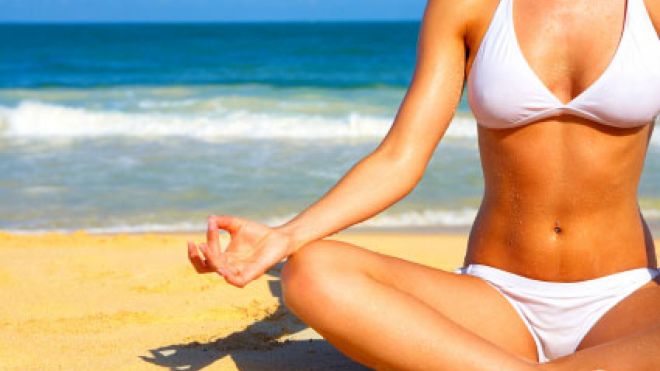
Don’t get in a twist over which type to choose. This guide will help you find a practice—whether you’re looking for muscle tone or peace of mind.
1. Hatha
Ideal for: Beginners.
What it is: Hatha refers to any practice that combines poses, or asanas, with breathing techniques, or pranayamas. The goal of a basic hatha class is to develop flexibility and balance and to integrate breath into every movement, so it is generally relaxing and restorative. In fact, a study published in the Journal of Nursing Research found that just one 90-minute hatha class significantly reduced women’s feelings of stress. Participants often begin by chanting the syllable om, then move into a series of poses and finish on the floor in a supine position called shavasana for 5 to 15 minutes, Julie Wood, the director of programming for YogaWorks, in New York City and California, said.
Related: 10 Things Trainers Wish You Knew About Your Workout
Good to know: You can gauge the intensity of a class by asking the instructor how quickly you’ll be moving (or “flowing”) between poses. If the answer is rapidly, you may want to find a slower-paced class for your first few sessions.
2. Vinyasa
Ideal for: Weight loss.
What it is: This fairly fast-paced style, sometimes called power yoga, requires you to move continuously throughout the class. The most well-known vinyasa sequence is the sun salutation, a flowing series of lunging, bending, and stretching asanas. Expect to do standing and seated poses that develop strength, flexibility, and balance. You’ll also spend some time on inversions, such as a shoulder stand or a headstand, in which the feet are raised above the head. (Don’t worry: You work up to them over time.)
Related: Fun Hula-Hoop Exercise Routine
Good to know: Vinyasa burns up to seven calories a minute, according to a study published in the journal Medicine & Science in Sports & Exercise.
3. Iyengar
Ideal for: Anyone with neck or back problems.
What it is: Developed by yoga guru B.K.S. Iyengar in the 1930s, this method emphasizes proper alignment to strengthen the muscles and support the joints. You often use props, like blocks and straps, to help you get into poses. In the 90-minute to two-hour class, you’ll do standing, seated, and twisting asanas, as well as inversions and backbends. (If your pain is due to an injury, be sure to check with your doctor first before starting a program.)
Related: How to Start Running
Good to know: This style of yoga can improve chronic neck pain, according to the Clinical Journal of Pain.
4. Bikram
Ideal for: Building flexibility.
What it is: Founder Bikram Choudhury popularized this style of “hot yoga” in the 1970s. To mimic the climate in Choudhury’s hometown in northern India, studios are heated to a sauna-like 105 degrees Fahrenheit, with a 40 percent humidity level. “The heat loosens your muscles, increasing your ability to stretch,” Raffael Pacitti, the owner of Bikram Yoga Manhattan, in New York City, said. Each 90-minute class includes a series of 26 poses done twice through, sandwiched between two sessions of breath work (think rapid inhalations and exhalations).
Good to know: Avoid eating at least two hours before class, as being too full in high heat can make you feel nauseated. And don’t forget your towel and water bottle.
5. Kundalini
Ideal for: A more spiritual experience.
What it is: This form of yoga was developed to calm the mind and energize the body through movement, the chanting of mantras, and breathing. “The average session is made up of 50 percent exercise, 20 percent breath work, 20 percent meditation, and 10 percent relaxation,” Hari Nam Singh Khalsa, the director of Yogaheaven.com, said. The goal is to release the energy that kundalini devotees believe is stored at the base of the spine.
Good to know: Consider this style the most “out there.” If chanting is not for you, simply repeat the mantras in your head.
6. Ashtanga
Ideal for: Seasoned yoga practitioners.
What it is: This physically challenging style consists of an unvarying sequence of poses. “Typically, you execute 70 poses in one 90-minute to two-hour session,” Coni Pappas, the owner of White Orchid Yoga, in Clearwater, Fla., said. These will include 10 sun salutations, backbends, and inversions.
Good to know: Ashtanga requires strength and endurance, so you’ll get the most out of it if you practice regularly. Make a commitment to do the routine at least three times a week.
source : http://www.foxnews.com/health/2013/05/28/guide-to-6-types-yoga/